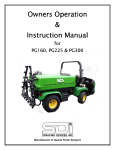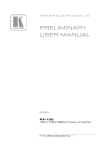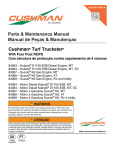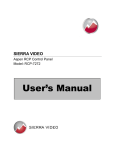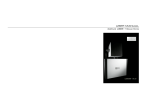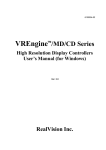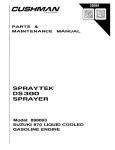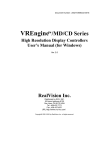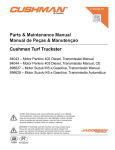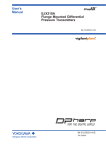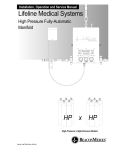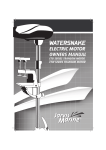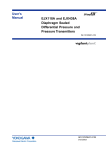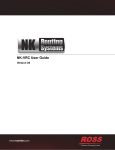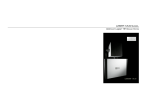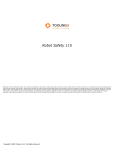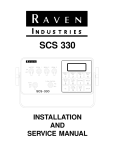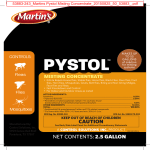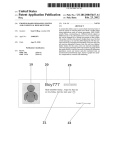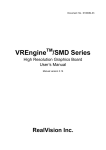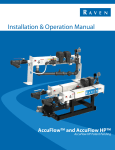Download VM Operation Manual
Transcript
Owners Operation & Instruction Manual for VM160D/DS, VM225D/DS, & VM300D/DS Manufacturer of Quality Power Sprayers 1 Table of Contents General Specifications / Frame / Booms 3 Safety Data 4 Control Identification 6 Pre-System Maintenance Check / Spray Tank / Pump Check 7 System Dynamics 11 Getting Started Calibration 13 Ground Speed 14 System Pressure Adjustments 17 Boom Spray Tip Overlap Check 18 Spray Operation 19 Troubleshooting 21 Operational Checks During Extended Product Application 21 More Operational Checks 22 Between Tank Loads 22 Sprayer Clean Up 23 Winterize 23 2 General Specifications - All Models Tank / Agitation: All SDI tanks are constructed from commercial grade fiberglass, hand rolled for maximum density and strength. The exterior is a high-gloss color gel coat with UV inhibitor. Each tank is equipped with an offset 16" screw-in lid with spring-assisted bullet venting and c-pillow perimeter ring gasket sealing system. Nylon mesh strainer basket with reinforcement ribs is included. The low profile tank design has a custom anti-vortex sump plate and venturi-jet agitation system. The external liquid level sight tube with calibration marks in gallons is located on the front corner of the tank. Custom color-match gel coat is on the tank exterior. Frame / Pump / Plumbing: The frame is fabricated from high strength welded steel and epoxy coated for durability. The pump is a positive displacement, 3cylinder piston-diaphragm design with integrated pulsation damper. The pump is conveniently mounted on top of the tank at the rear of the sprayer and is powered by the vehicle’s auxiliary hydraulic system. Plumbing is reinforced nylon, brass, SST and hoses are rubber or reinforced plastic/nylon/PVC blends. “Economy” Manual Lift Booms: Wet booms feature all steel support frames with variable adjustment mounting and height adjustment brackets. Equal-flow design includes equal length 304SST tubes with nylon end caps. Brass and nylon feeder saddles with ¾” inlet and ¾” feed hoses. Nozzle bodies are polypropylene, 10 PSI, diaphragm check assembly, ¼ turn on/off locking cap with gasket and 50 mesh slotted nylon tip strainer. Included spray tips are TeeJet TP11008VP. Other sizes, styles, etc. are available upon request for additional charge. Bi-directional breakaway hinge with forward and reverse action, fold-up for transportation and adjustable dampening spring are also standard. OPTIMUM Turf Booms (Standard and Convertible): The Optimum Turf Booms feature precision welded nozzle mounts. This error proof design keeps all nozzles in perfect alignment versus other designs. The heavy duty bi-directional breakaway hinge has swag style cable level anchor system and also has the ability to fold forward. Optional 12 volt actuators are available for independent wing section raise and lower. Triple nozzle bodies are standard with the included TP11008VP spray tips. The 15/21 foot convertible boom offers flip-out wing extensions for increased area coverage. 3 Pump / Drives / Specs / Capacities – All Models: Pump: Hydraulic driven, 3-cylinder positive-displacement piston-diaphragm. Maximum Capacities/Pressure: Up to 30 GPM @ maximum vehicle hydraulic output capacity. Up to 200 PSI maximum system pressure developed at relief valve pressure gauge with the agitation gate valve closed. The pump hydraulic drive system reaches maximum performance when the vehicle’s engine speed exceeds 3000 RPM’s. Vehicle operating RPM’s may change the hydraulic system output which affects pump speed/output. Factory settings allow sprayer to operate in the most common vehicle engine RPM/gear settings for spraying (2-7 MPH). Other extreme spraying requirements may require minor component adjustment with tips from the factory for best results/performance. Safety Data: This symbol is a safety warning and appears next to information which may help keep you and others from being injured. SAFETY WORDS – CHEMICAL MATERIAL DATA SHEETS (Know what you are spraying and safe handling techniques). CAUTION: WARNING: D A N - GER: Recommended Safety Equipment: Required to prevent accidental exposure or poisoning. (Consult chemical supplier for proper material compatibility.) Spray Suit – Full coverage (arms and legs) – free of rips or tears. Shield – To prevent accidental facial contact with chemicals. Goggles – To cover eyes (glasses for better protection). PVC/Nylon Gloves – Protects hands and sleeve openings. Mask/Respirator – Approved canister type with appropriate filter cartridges for chemicals being used. 4 Work Area Safety Recommendations: Chemical Storage – check local regulations – vary by region. Sprayer Storage – check local regulations – vary by region. Fill/Mix and Load Station – area should not be high traffic and should have run-off containment. DO NOT allow non-spray personnel to enter mix area. All mixing should be performed with proper safety gear in place. Water Supply – if using public water system, recommend using anti-back flow protection on fill hoses and water source outlets. Air gap filler (anti-siphon) is available as an option. Fill Hose – should never be put into spray tank, you could contaminate hose (a habit that should be avoided). Overflow/Over Filling – recommend recovery or containment system. If not available, be certain run off does not contaminate public sewers or natural wetland areas. See local regulations. Moving Mechanical System Parts – keep hands away from rotating pump shaft and restrain loose clothing. Use caution around system when in operation. Broken or Worn Components – follow recommended safety and repair/maintenance schedules. DO NOT operate without proper safety gear or operate if machine is not in proper working order. Proper operation is not only safer but, it can save you money by properly applying the desired chemicals at the correct rate. Accidents/Problems – in case of injury, accident or unprotected exposure, notify your supervisor of incident and if necessary, contact poison control board, EPA, local fire department to help with the situation. Record Keeping – proper records showing chemical being used, batch size, time, date, areas treated, weather conditions, unusual occurrences can protect you and others should any problem occur after a turf application has been made. Local/State Regulations – request, read and follow all local and state regulations for your area. These will vary by region. Be informed, not a victim! Licensing – it is recommended that all spray technician operators secure proper CPA (Certified Pesticide Applicators) license or equivalent. Check your local regulations. Warning: SDI strongly recommends that you read and understand completely, the Operator’s Manual for the specific truck you mount the sprayer to – be confident and sure of your skills before operating the truck with the sprayer attached. The large liquid payload reacts differently during vehicle movement, than an equal size dry load! Please Use Caution! 5 Electronic Motorized Boom Control A – Pressure Gauge B – Pressure Adjustment Switch (Up/Down) C – Master Boom On/Off Switch (Controls 1, 2, 3) 1 – Boom 1 (Left Boom) 2 – Boom 2 (Center Boom) 3 – Boom 3 (Right Boom) EC-VMAFS -- All Function Control Box A- Master On/Off Boom Switch B- Pressure Adjustment Switch C- Individual Boom Section On/Off Switches D- Foam Marker Left/Right E- Foam Marker Both Left & Right F- Electric Lift Switches G- Pressure Gauge H- Control Box Power Switch I - Power Indicator Light Raven SCS330 Boom Control with Motorized Valves A – Master On/Off B – Boom 1 C – Boom 2 D – Boom 3 E – System Select Power Switch F – Rate Adjust/Override Switch (controls pressure/flow servo valve) G – Rate/Data LCD Screen (shows flow rate and active key pad function) H – Data Input Key Pad Complete system diagrams in Setup and Parts Manuals (consult for system layouts and component locations). **Please refer to The Raven Manuals for descriptions and features for that model. 6 Pre-System Maintenance Checks: See your Vehicle’s Operation/Maintenance Manual for specific instructions. Spray Tank Checks: Frame hold down hardware – tight and unbroken. Visually inspect fiberglass spray tank for leaks or cracks. Visually inspect sprayer frame for cracks or broken welds. Check all fasteners for tightness – replace worn items as needed. Lid and Gasket (Lid Threads) inspect for leaks or warping, wipe off dirt from threads and gasket. Apply light lubricant to gasket, such as silicone spray. Check operation of spring-assisted bullet vent in lid center. Replace pillow lid gasket if damage is present. With lid open and basket removed, visually inspect the inside of the spray tank for flaking, residue buildup, check anti-vortex plate (black circle in sump area) and sump box for debris, i.e. rags, instructions, etc. Remove as needed. Blocked suction can result in poor performance and pump problems. Periodically check ceramic orifice discs in venturi nozzles for cracks or blockages. These problems can lead to reduced agitation and possible products mixing problems. Replace or clean as needed. Pump and Power Checks: Inspect hoses for rubs, cracks or any damage that could result in a leak of fluid – repair as needed. CAUTION: Normal vehicle engine RPM operating range for sprayer use is 1500 to 3500 RPM’s and 1st, 2nd, and 3rd gears in the low range. Consult the factory if you need to operate the machinery at settings other than those specified. Inspect exterior of pump, drive motor, and hydraulic supply hoses for damage or leaks that could cause problems later. Consult manuals for repair options. With each fill of tank, inspect the pump’s see-thru oil reservoir for evidence of diaphragm failure. Oil will appear milky or cloudy if a diaphragm has damage. Inspect bowl and gasket – improper gasket seating can result in poor pump performance. Replace with correct size gasket only! During bowl replacement, only hand tighten! DO NOT USE ANY TOOLS! Remove black nylon suction strainer bowl and clean screen of any debris. A 20 mesh screen is standard. Using 40 mesh or finer will require more frequent checks for debris in the screen. A plugged screen can result in decreased fluid availability to the pump (starved-suction condition). The resulting effects can range from reduced output to torn diaphragms. Check bottom load 3-way suction ball valve and turn handle to pump suction (arrow points 7 Check to see that agitation control valve is fully open. Turn knob to the left (counter clockwise) to open. Due to the unique design of the tank bottom suction and anti-vortex area – turning the agitation down or off when the tank is low is not necessary. The tank will pump down to dry with the agitation fully on. Spray Boom Checks: Inspect mounting hardware and support frame for fastener tightness and worn or broken components. Repair as needed. With vehicle tires properly inflated and tank full of water, check boom for level and proper height. See Setup Manual for proper adjustments. Grease boom hinges (breakaways), be sure and remove any debris (i.e. grass, sand, dirt, etc.) from greased area on pivot plates. Adjust return spring tension to stiffer or looser action. See Setup Manual for details. With booms in the down (operational) position, check for level again. Between sprays, check and clean all boom nozzle assemblies. Inspect check valve diaphragms for tears or warping, check and clean tips with a soft nylon tip brush. Clean strainer screens and tip gaskets also. Replace worn or defective items as needed. Proper tip maintenance will result in optimum performance and pattern development. Motorized Boom Control Checks: Check battery connections – alligator clips – for proper pole (+/-) hook up. Check wire fastener screw on clips for tightness. Remove any corrosive terminal buildup. Check control box mount and console wing nuts for tightness. Clean dirty console with a damp cloth (mild soap). DO NOT USE solvents. Check all toggle switches for excessive play and replace as needed. If switches are rubber booted, check boots for tears and replace worn ones. Check control console pressure gauge bezel (clear plastic ring which holds gauge into console). Raised tabs should be at 6 and 12 o’clock positions. Check back side of console and make sure power and control cable assemblies are locked into multi-pin connectors. Then replace protective rubber boots. Check fuse and rubber boot. Check plastic pressure gauge tube for kinks, breaks or blockages. To clean a blocked tube (packed with dry powder), #1 – put some clean water in the spray tank (2-5 gallons), #2 – turn sprayer on and set RPM’s to 3000 on truck, #3 – on back side of console, is a metal tube receiver with 1/8" tube engaged. Push tube and top of metal coupler with your thumb and index finger, #4 – while holding metal ring in, pull tube out with your other hand, #5 – point disengaged tube away from box and face, and allow debris to clear from tube, #6 – if unsuccessful, stop and shut sprayer off, #7 – disengage other end of tube from boom valve inlet, #8 - use rubber tipped air nozzle to force high pressure air through tube, #9 – if unsuccessful, replace with new tube and start flushing new tube after each spray application. Move back to rear of sprayer – boom area. 8 Inspect motorized valve harness connector plugs – they should be tight against valve body – screw tight – no prongs showing from valves. Check valve mating joints (seams) for product leakage. If leakage is detected, tighten nuts on the 4 guide rod bolts and bring valves closer together. Not too tight – o-rings are in each joint area. If leak persists, separate valve bodies and replace o-rings with new ones. Check that all horseshoe clips on boom feed barbs and metered by pass valves are pushed in and secure. Leakage can result if u-clips are not in place. Move back to control console – LISTEN carefully as you perform the next checks. Push up on pressure adjust toggle switch – servo motor on yellow striped valve should run. Reverse toggle position and verify motor works in both directions. Failure – See Troubleshooting Section. Push master power toggle to on position – now one switch at a time, try each boom, 1-2-3, in both directions. Slowly verify the working in both directions of each motorized valve. Raven Boom Control Checks: Procedures are similar to Motorized Valves – refer to supplied RAVEN Manual for test procedures. Inspect and wipe debris from console with a damp cloth. Verify your preset calibration numbers – DO THEY MATCH YOUR RECORDS SHEET IN THE RAVEN MANUAL? Modify any numbers that do not match. Check all harness connectors on back of box. Inspect speed sensor assembly, especially the magnets if that style is in use. Clean any debris from the face of the magnet and check alignment/orientation to the center of the pick-up sensor. If radar is in use, check orientation to ground and wipe sensor face of any debris. Consult Raven Manual for additional information. Place control box power switch to manual position. Check motorized valve operation – same procedures as standard controls – exception (NO metered bypass). If Raven system is equipped with RADAR speed sensor, see Raven Manual for check list and test procedures. Electric Boom Lift (optional): For setup and complete instructions, see Boom Lift Owners Manual. Check both actuator mounting bolts for tightness and for wing down position parallel to ground position, adjust level to ground with swag cable anchor eyebolt. Periodically spray a penetrating lubricant onto pivot points and hinge bushing assemblies. Check control harness fuse – 30 amp rating. Check control console toggle switch for play and proper operation. Check harness connectors at control box pigtail and each actuator pigtail hookup. 9 Foam Marker (optional): For setup and complete instructions, see Foam Marker Owner’s Manual. Inspect solution tank for leaks or cracks. Check cap assembly for cracks or leaks. Check fuse in control harness – 10 amp rating. Activate power switch to left and then right positions and verify compressor will start up and if container has fluid, liquid should flow to feed blue tube on corresponding foam generator cone and foam should start or liquid will drip from outlet steadily. Foamer uses two solenoids per side activation. One for air, one for solution – both are inside of black turtle shell cover with a matching pair for the other side and the main compressor unit. White hoses carry air to system, blue hoses carry solution. Hose connections are colored coded white or blue, so are fly nuts and hoses. Just match the colors and make sure to get adequate hose on bib contact before tightening down on fly nut fastener. If system fails to start, check 12 volt power supply first. System is run/tested at the factory prior to shipping to your dealer for installation. A running system will not foam with water only – 160:1 ratio (water: concentrate) or similar solution must be added to the solution tank’s water. SDI foam concentrate is recommended for best machine performance. Check supply hose fasteners on boom tubes for proper position, tightness, and routing. Should not interfere with tips or nozzle check valves – Loom (black ribbed cover) should run along the top of boom tube fastened with nylon zip ties. Check foam generator cone position. Should be at boom wing end and clear spray pattern distribution area. Keep the cones out of spray by tilting up (required for raindrop style tips). Hose Reel (optional): Check supply hose from pressure side of pump to swivel inlet on reel drums for cuts, scrapes, kinks or leaks. Lubricate reel swivel at grease zerk – if equipped. Check reel to tank fastener hardware for tightness and evidence of leaks. Rubber well nuts and fender washers should be used with SST bolts. See Hose Reel Mounting Instructions and fastener use sequence. If electric rewind, check battery and all power harness connections. 40 amp circuit breaker should also be part of electrical hookup. 10 System Dynamics How Your System Works – Why they call it a sprayer: POWER – Utility vehicle’s auxiliary hydraulics provides fluid to sprayer’s pump drive motor. On/off control lever is located on the center control console. Pull the lever back to activate the auxiliary hydraulics. TRANSPORTATION – Sprayer/truck mounting style makes the two systems act as one complete machine. Fluid path through sprayer – items 1 through 12: 1. Spray Tank – containment for fluid and product mix chamber – made of fiberglass and resin compound. Unique bottom shape is attached to directional side gutters to effectively direct solution to the tanks rear sump. This design allows sprayer to maintain performance even at low liquid levels. Design also works as damper (anti-slosh control) for operating with less than a full tank. 2. Anti-Vortex Plate – located in sump (lowest part tank interior), facilitates complete liquid draining without causing pump suction loss or prime break. Attaches to suction flange. 3. Suction Flange – external hose barb assembly on tank sump area – connects tank to main suction hose. 4. Suction/Off/Drain “Bottom Load Valve” – large 1½” 3-way ball valve (all-in-one design). Arrow on handle points in direction of fluid flow – up (suction/pump) – side (off) – down (drain). Off allows cleaning of suction’s strainer screen with loaded tank. Pump should only be running when arrow points up (suction open) – pump diaphragm damage can occur when valve is off or drain position while running (starved suction conditions). 5. Suction Strainer – filters out particulate matter and debris from supply tank. Extends pump life and eliminates foreign objects which may disrupt normal boom or gun operations. 6. Diaphragm Pump – piston/diaphragm design uses desmophan diaphragm attached to a piston’s top and supported by trapped oil from pumps main case. 7. Pressure Regulator – controls pressure to spray boom and accessories. T-handle turns clockwise to raise system pressure and counter clockwise to lower system pressure. Once desired pressure is reached tighten lock nut on base of T-handle to fix the setting. Once system is charged to set limit, an internal spring and seat releases the excess pressure and fluid for low pressure recirculation back to the tank through the bypass hose. 8. Agitation Control Gate Valve – controls amount of tank agitation by amount of liquid through Venturi nozzle multiplier orifice. Recommend you leave full open at all times. No need to close with low tank liquid level. 9. Jet Agitation – located above the sump channel at the back of the tank. 6 venturi style nozzles with ceramic metering orifice disc multiply the exiting fluid and disperse materials throughout the solution tank – hydraulic mixing. 10. Hose Reel – hose holding spool which allows hookup of spray system to a spray handgun or walking type spray boom. Holds and organizes supply/spray hose for repeated organized uses. 11. Boom Controls – supplies liquid to motorized valve assemblies for dispersal (through the spray boom). 11 Notes on System Dynamics Diaphragm Pump Lubrication – internal mechanical components operate in a flooded oil bath environment – the pump’s cylinder diaphragms keep contaminants/spray solution from entering the oil’s environment. Diaphragms should be inspected yearly and replaced when wear or abnormalities are discovered. Case mounted see-thru oil reservoir will cloud or be cloudy if spray has entered the oil’s environment. Pump can handle all materials and run dry (no solution) without damage. Venturi-Jet Agitator Nozzles – installed with ceramic metered orifice disc (long wearing vs. plastic). Long lasting ceramic discs provide stable agitation flow rates for trouble-free fluid mixing. Suction Strainer – provides liquid filtering of particulate matter in spray material. Screen mesh sizes available: 40, 50, 80, and 20 (standard) in SST material. Should be cleaned daily or more often as the need arises. Non-Corrosive Plumbing – all spray plumbing is SST, nylon or PVC or polypropylene for all liquid handling parts. System Dynamics – Materials Compatibility SDI’s diaphragm pump is capable of pumping almost any nonflammable liquid without trouble or damage to the pump. On extremely thick or gritty suspensions, it is advisable to operate the sprayer with the suction strainer screen removed. Clogging up the screen can starve the pump and cause premature diaphragm damage. For materials with high residue, it is advisable to rinse pump and plumbing as soon as you return to the sprayer fill area. Avoid heavy, thick dye markers and add dyes into a full mixing tank, not an empty filling tank. See Troubleshooting Section for scrubbing suggestions. Spray Liquid Viscosity – the addition of certain WP, WDG, EC’s etc. may cause the viscosity (thickness) of the water to increase. This can sometimes affect the calibration of the spray nozzle output at pre-calibration water numbers. Consult chemical supplier for recommended modifications to your system. Specific Gravity of Sprayed Suspension – water on average weights 8.34lbs./gallon – when you add mix to the water, the weight will change. Sometimes the solution gets lighter less than 8.34lbs./gallon and sometimes it gets heavier than 8.34lbs./gallon. Weight of solution changes the affect output calibrations of nozzles. See Table and Formulas to make necessary adjustments to compensate. Especially critical when using computer controlled rate systems. 12 Getting Started: Practice with water – after you have followed all recommendations, it is advisable to familiarize yourself with the operation of the new truck and sprayer package. Practicing with plain water before the addition of expensive and destructive chemical formulas (when miss-applied) can be smart and cost effective. Practice and calibrate before you spray dollars away! Know your machine and its operation. Calibration – First Step to Spraying: To spray and spray accurately, you must have a set of standards to spray by. They are: Desired Application Rate (GPA or G/1000 FT²). Nozzle spacing (W”) – Distance between spray tips. Desired Ground Speed – recommend a fixed (governed) speed MPH to maintain accurate calibration. Tip style-type of pattern for particle distribution for applicable chemical to be applied, i.e. FL, XR, TT. Tip Size – determines volume per nozzle and desired droplet (micron) size of spray carrier particles. When used in the following formulas, the application rate can be maintained by fixing the constants for each category. See Technical Information Section. The easiest method of calibration is to use as many fixed constants that can be controlled, and then modify the tip size and output pressure to lock in your desired application rate. Technical Information: Useful formulas: GPM (per Nozzle) = GPA x MPH x W (in acres) 5,940 GPM (per Nozzle) = GAL/1000FT² x MPH x W (in square feet) GPA 136 = 5,940 x GPA (per nozzle) MPH x W GAL/1000FT² = 136 x GPM (per nozzle) MPH x W GPM – Gallons per Minute GPA – Gallons per Acre GAL/1000FT² - Gallons per 1000 Square Feet MPH – Miles per Hour W – Nozzle Spacing (in inches) 13 A – Nozzle volume required to obtain desired GPA rate at desired speed and spacing. See TeeJet Catalog for style and size of tip to complete job. B – Nozzle volume required to obtain desired GAL/1000FT² rate at desired speed and spacing. See TeeJet Catalog for style and size of tip to complete job. Specific Gravity Adjustments (When You Spray More Than Water): typical US gallon weighs 8.34lbs. Most manufacturers’ nozzle charts show performance with water only. Example: target application rate – 50 GPA (water specific gravity 1.0), add 28% nitrogen to the solution typical weight per gallon is 10.65lbs. (28% nitrogen in water specific gravity is 1.28) The Formula GPA (solution) x conversion factor = GPA from table 50 x 1.13 = 56.5 GPA corrected This new output could require a different spray tip. *Specific gravity can be determined by weighing a measured gallon of your solution once mixed. Then use the table to find your conversion factor. Ground Speed: Turf Truckster® vehicle offers 5 speeds forward and one in reverse. Most spraying will be done in 1st, 2nd and 3rd gears and RPM’s between 1500 and 3500. The hydraulic drive pump will operate in this range but will have reduced output at RPM’s below 2500 on the engine. High volume outputs should be done at the 3500 RPM setting. Use the “Measure Travel Speed” formula to gauge your exact speed for calibration formulas and tip selection. See Tachometer/Speedometer picture. 14 Miscellaneous Conversion Factors: One Acre = 43,560 square feet = 43.56 1000FT² blocks One Acre = 0.405 Hectares One Hectare = 2.471 Acres One Gallon per Acre = 2.9 Fluid Ounces per 1000FT² = 9.35 Liters per hectare One Gallon per 1000FT² = 43.56 Gallons per Acre One Gallon = 128 Fluid Ounces = 8 Pints = 4 Quarts = 3.79 Liters = 0.83 Imperial Gallons One Mile = 5,280 Feet = 1,610 Meters = 1.61 Kilometers One Pound per Square Inch = 0.069 Bar = 6.896 Kilopascal Example: (GPM/NOZZLE) = GAL/1000FT² (1) x MPH (2.9) x W” (10) = .213 136 Based on the chart, a tip pressure of 45 PSI with the yellow, or 20 PSI with the blue XR TeeJet tips, will apply the proper amount based on Speed/Spacing/Rate Constants. The chart above is from the TeeJet Catalog. For a complete listing of tip options and charts, call SDI or your local dealer for a new TeeJet Tip Catalog or visit www.teejet.com. 15 Suggested Minimum Spray Heights – Turf Nozzles: TP11008VP polymer test tips supplied with every SDI boom. Order other sizes or styles from SDI’s Parts Department. Mixing and Loading Pesticides Product Active Ingredient Formulas or How Much Pesticide Do I Add to My Spray Tank? To determine the amount of pesticide to add to the spray tank, you need to know the recommended application rate of pesticide, the capacity of the spray tank, and the calibrated output of the sprayer. The recommended application rate of the pesticide is given on the label. The rate is usually indicated as pounds per acre for wettable powders, and pints, quarts, or gallons per acre for liquids. Sometimes the recommendation is given as pounds of active ingredient (lb. per active ingredient) per acre rather than the amount of product per acre. The active ingredient must be converted to actual product. 16 System Pressure Adjustment: Pressure adjustment procedures vary by control style Set Pump Output Pressure to Agitation - set speed limiter on vehicle’s throttle to an operating RPM that corresponds to desired MPH with selected gear and range of spraying. Open suction valve on sprayer, then pull auxiliary hydraulics lever on vehicle’s center console. Go to pump assembly and close all outlet valves (agitation, boom supply, and hose reel). This will give the system a closed loop for proper setting of the system pressure relief. Adjust relief valve by loosening lock nut then turn T-handle to right to increase (raise) pressure or to the left to decrease (lower) system pressure shown on the pressure gauge. Set pressure in closed loop to 90 – 100PSI. Once system is set to fixed pressure you can open and set the tank agitation output. The gate valve will allow a full range of setting by turning the knob left for more agitation or turn the knob right for less. The maximum allowable flow is metered by ceramic orifice disc inside the venturi jet nozzles. System pressure may drop but should remain above the maximum needed for boom spraying (15 60 PSI). 12 volt Motorized Boom Valves Follow the same setup procedures on pump and relief valve adjustment to set system pressure to 90 – 100 PSI. The electronic controller has switches in lieu of levers to control boom functions. Turn all switches on console box to off position and hold down on pressure adjust switch until pressure will go no lower (motorized regulator in full bypass/open setting). Again, turn all metered bypass knobs on motorized valves to the right until closed. Push up on pressure adjust switch until the console mounted gauge reads 40 PSI then stop. Push boom switches 1, 2, and 3 to up/on position then activate the boom master switch to the up/on position. All three boom sections should be spraying and console gauge will probably show less than 40 PSI. Use the pressure adjust switch to raise the boom pressure to 40 PSI. With system at 40 PSI, turn boom switch #1 switch to off – pressure should rise above 40 PSI. Move to motorized valve and open metered bypass knob on/off valve until pressure drops back off to 40 PSI. Position yourself so you can see the electronic console’s gauge or have someone help you by calling out when you have adjusted back to 40 PSI. Cycle the #1 boom switch on and off as you watch the pressure gauge reading. Except for a short bounce of the gauge’s needle, the final pressure should read 40 PSI. If it is ok, repeat steps for boom #2 and then for boom #3. Your metered bypass is now ready for operation. 17 Raven Computerized Controls Computer equipped sprayers can operate in the manual mode and follow same guidelines as standard motorized adjustment (no metered bypass to adjust when Raven is used). Raven should be in manual mode to adjust pressure on the system. Note: the Raven System works on flow, not pressure. You will not be able to keep the rate exactly on because the machine will respond to every little system change. When the computer is in control, it makes corrective adjustments many times faster than the operator could even think about. So do not let it worry you. Boom Spray Tip Overlap Checks: To verify the boom is properly set up and tip/nozzle height is correct, a water only pass over a dry concrete or asphalt parking area, can reveal much information about your system’s setup. With only water in tank, operate machine and spray with boom full on and drive and apply a pattern to the dry driveway/parking area. After the first pass, watch the spray dry and look for uneven areas or extra wet of dry zones. Uniform and even drying indicates the system applying a uniform pattern. Checks of each nozzle with a calibration catch container can assist your data on the system. Uneven drying or wet stripes can identify overlap problems. Wet stripes between nozzle tips can mean the boom is too high – striped under the nozzles may indicate the boom is too low. Proper tip height and overlap are found in the Setup Section. The supplied TP11008VP polymer test tips are a tapered flat-fan design and require a minimum of 30% overlap when mounted on 20" spacing (this is a tip to ground height of 18" minimum). Consult the manufacturer’s recommendations for the style of tip you plan to use. Patterns, overlaps, sizes, materials, droplet size, and pressure range can change with the tips selected. Test with water if you have no experience with new nozzles. 18 Spray Operation: The sprayer was designed to operate at an engine speed of 1500 RPM’s to 3500 RPM’s. The hydraulic drive diaphragm pump reaches full volume at 3000 RPM’s on vehicles tachometer. Park vehicle on level ground with parking brake on – truck in neutral and engine off. Safety equipment should be used during all sprayer operations as a rule. Safety equipment should be in good condition, with no rips, holes, or tears. Sprayer mix and load area should not be a high traffic area or visited by workers who are not properly protected with safety equipment. If equipped with an anti-siphon device (air gap filler) for back flow protection, rotate and lock gooseneck filler into position. Attach water feed hose and slowly turn on water source and bring up to full stream (without splashing out). We recommend the strainer basket be left in place and used to strain all materials being put into the fiberglass tank. Suction strainer should be installed if not already in place. Also, open the bottom load valve to the pump at this time. Determine amount of spray mix to be used for your application. If required amount is less than full tank capacity, fill to desired level. Place truck in neutral with parking brake engaged. Start engine according to procedures outlined in Truck Owner’s Manual. Using throttle lock (manual or electric), set engine speed to 2500 RPM’s. On vehicle’s center console – pull auxiliary hydraulics lever back and turn the pump drive on. If not operating, review the Troubleshooting Section for ideas. A quick look into the open lid assembly can verify the pump is working through the movement of the tanks contents (water). Agitation control valve is located with the pump and relief valve on the back section of the spray tank. **NOTE** if system fails to work as described, shut auxiliary hydraulics to pump off and check Troubleshooting Section for possible cures. Once system is operational, a quick system test should be performed before adding product to the mix tank. Lower boom wings to the operational position. Be sure area is clear of non-authorized spray personnel. Turn on Master Boom Control (switch or lever) and adjust pressure to desired rate. Check boom assembly for leaks. Inspect hose fittings, nozzle assemblies, end caps and the complete system. Repair and/or re-tape any leaking fittings. STOP all drips! All nozzles should come on and develop a full pattern. Clean or repair all nonworking assemblies. 19 **NOTE** System Calibration and Product Active Ingredient formula calibration sections should already be completed. If not, refer to the appropriate sections and compute your application data before continuing. With calibration formulas completed, tips sized, dry run calibration and nozzle pressure set, you may now proceed. Restart truck and engage the pump and agitation system. Spoon feed (add slowly) the chemical to be applied to the agitating tank water. The addition of some products, all-at-once, may cause damage by plugging the in-line suction strainer screen which can cause a starved suction condition. Product labels (WP, EC, WDG, etc.) are abrasive in nature and should include extra mix time in the tank. Prepackaged dissolvable bag types are also difficult to mix rapidly. The slow dissolve of the wrapper may lead to clogged suction strainers under certain “hasty” conditions. Liquid products can mix easier than most dry formulations, but can be difficult to mix in cold water areas. Consult with your chemical supply rep for any precautions or mix-it-up suggestions for any unfamiliar products. Mix times may vary by chemical, load size, water temperature and operator skill (experience). Normal mix times can be 20 to 30 minutes per tank! This allows enough time to provide complete particle distribution throughout the complete mixable liquid in tank. Just because the water is murky and clouded doesn’t mean all the chemical is mixed up. Give it some time! Haste during critical mixing phase by spraying to soon, may cause severe damaging rate changes from what your original rate was suppose to be. Example: 1st 1/3 of tank could apply more than the desired rate when heavy products are not fully suspended in the carrier water. The 2 nd 1/3 could apply close to the right rate while the final 1/3 would be light on active ingredients. This is only a possible scenario – adequate mix times will eliminate these costly errors from happening! At the completion of chemical mixing phase, you are now ready to apply the chemical mix to your fine turf areas. If machine is equipped with SDI’s Quick Foam Marking System, refer to Operation’s Manual for application techniques. Foamer use should be restricted to fairway and rough area with longer turf grass heights. Use on greens and tee area can cause browning under slow dissipating foam balls during high air temperatures. Be sure to allow enough spray overlap on end nozzle to cover the foam ball with a dissipating spray. This technique allows for proper pattern overlap and the water from the spray speeds up the foam ball’s disappearing from the turf area. **NOTE** Failure to hit the foam ball with the spray from the end nozzle will result in an area of turf that is not being treated with your spray. 20 Troubleshooting: Cannot get enough pressure: Settings exceed pump capacity Vehicle’s auxiliary hydraulics not working or switched on Spray tips too large Tank empty Hydraulic fluid in system at low level Bottom load valve on pump suction off or partially closed Liquid foaming in tank Suction vacuum leak/crack in hose Suction strainer screen clogged Operational Checks During Extended Product Applications: Frequently check your control pressure gauge for any change from original calibration set. A rise in the pressure should alert you to a clogged or partially clogged spray tip orifice output. Routine nozzle screen cleanings and use of all factory standard strainer screens will greatly reduce this from happening. Another possible cause for pressure rise could be the increase of engine speed. We recommend the use of a truck governor or throttle lock set for accurate speed (maintains power accurately under variable load conditions). One last cause for a system pressure increase could be from the increase in hydraulic oil temperature. As the hydraulic oil’s temperature goes up, the viscosity gets thinner. Under ideal conditions, the thinner oil can pass through the hydraulic motor easier which may increase the number of RPM’s. This small increase can be managed through the use of the pressure adjust feature on the sprayers boom controls. Pressure loss can also occur during a spray application. Loss of engine speed, loss of a spray tip or the excessive wear on all tips as compared to a noncurrent calibration check. Frequent checks of system calibration results in better system performance. The use of SDI’s Motorized Valves with metered bypass can also affect the system pressure if not properly adjusted. Refer to Motorized Valve adjustment procedure for more help. Another possible cause of pressure loss on the system could be the result of a clogged suction strainer. Your system uses a self-priming diaphragm pump. If the suction strainer screen becomes clogged, it restricts the flow of water to the pump. Keep your strainer screen clean and it will protect your diaphragms too! Also, be sure the strainer bowl is properly tightened with the gasket in place. An improperly tightened bowl can result in a suction leak which will result in loss of fluid to the pump. 21 More Operational Checks: If equipped with a speedometer, verify speed occasionally. The use of the ground speed governor or throttle lock control can maintain ground speed to keep your application rate on target. Stable speed is one of your necessary sprayer constants. Boom wing orientation (levelness to the ground) option can assist over uneven terrain. During turnarounds, while stopped, visually check the tank liquid level sight tube for the amount of spray left in the tank. DO NOT do this operation during forward movement. Keep your eyes forward to avoid collision accidents. If using a Raven computer controller, periodically check the data/rate screen for proper rate output. If not holding the desired rate, consult Raven’s User’s Manual or contact your local dealer or the factory. Between Tank Loads (refills): Check vehicle fuel level – fill as needed. Check solution tank on Foam Marker – fill as needed. If using wettable powders or equivalent, check suction strainer and nozzle tip strainers for possible debris build up. Clean as needed. Avoid costly and messy “in-field” service of plugged nozzle screens by checking and cleaning often. Refer to your calibration charts and area measurements to verify your application coverage. Make any necessary adjustments to obtain your correct rate. A 10% error in application rate can cost you hundreds of dollars in lost time and chemicals, not to mention the possibility of turf grass damage. When the Job is Finished / Sprayer Clean-Up: Sprayers are often neglected during the winter, at the cost of valuable time and money in the spring to fix cracked or broken fittings, hoses, or pumps that have seized. A sprayer is a long term investment. All sprayers’ components, from tank to tips, should be checked. Items that need replacement should be listed. Replacement parts should be purchased during the off-season. Sprayers should be protected against the harmful effects of snow, rain, sun, and strong winds. Moisture in the air, whether from snow, rain or soil, corrodes metal parts of unprotected equipment. The sun helps reduce moisture in the air, but it also causes damage. Ultraviolet light softens and weakens rubber materials such as hoses. The best protection from the environment is to store sprayers in a dry building. Storing sprayers provides an opportunity to work on them any time during the off-season, regardless of weather conditions. 22 Clean Up: Prior to storage, clean the sprayer thoroughly with a cleaning solution. Which solution to use will depend on the pesticides used during the season. Always check the pesticide label for specific cleaning instructions. During cleaning, follow these general tips: Use a cleaning solution containing 2 pounds of detergent for each 30 – 40 gallons of water. This should be sufficient for removing most pesticides. First, flush the sprayer clean with clean water. Then add the cleaning solution to the tank. Agitate thoroughly and allow the water/detergent solution to circulate through the system for several minutes. Remove nozzles and flush the system twice with clean water. Clean nozzle tips and screen in a strong detergent solution or kerosene, using a soft brush, such as an old toothbrush. Some pesticide combinations (especially if oil is used) may produce a putty type paste in the tank. Flushing out the residue of such chemicals after each load prevents an accumulation. During the final cleaning, examine the hoses, clamps, connections, no-drip valve, nozzle tips and screens for needed replacement. Winterize: After the final cleaning, follow these tips to get the most out of your sprayer’s life: Remove no-drip valve, nozzle tips, and strainers and dry them thoroughly. Clean tips with a toothbrush only. Store metal tips in a can of light oil, such as diesel fuel or kerosene. Store tips constructed of plastic and nylon in a dry place. Make a special effort in storing tips so that the orifices are not damaged by contacting each other or other parts such as loose screws. Drain water from all parts to prevent freezing. To insure the hoses are completely drained of water, purge them with compressed air. Tape or cover all openings, so that insects, dirt and other foreign material cannot get into system. Check the sprayer frame for scratched areas. Touch up these areas with paint to eliminate corrosion. Store sprayer in a clean, dry location within a building. If storage in a building is not possible, provide some sort of cover. Remove hoses, wipe them clean of oil, and store them inside a building. DO NOT hang them over a nail or sharp object. This causes a permanent crease that reduces flow through the hose. Coil hoses around a basket or other large round object to prevent sharp bends. 23 P.O. Box 3107 Visalia, CA 93278-3107 (559)SDI-5555 / Fax (559)SDI-5591 www.sprayingdevices.com 1961.7/12sb 24
























